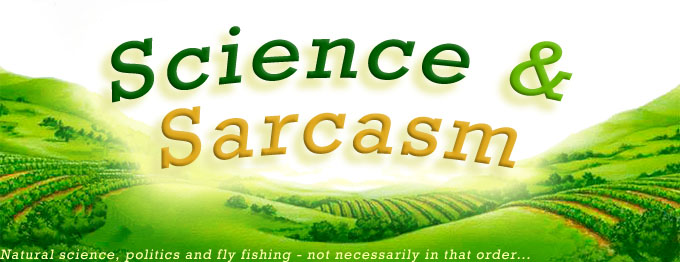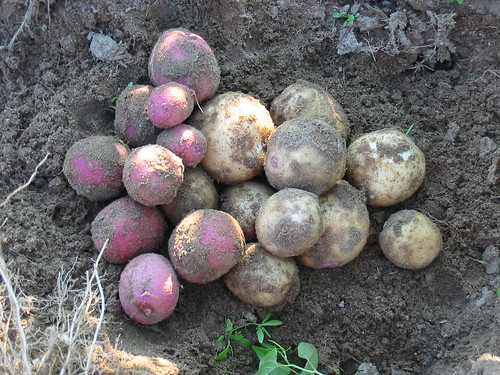Science can be tasty!
I've been enjoying new potatoes from my garden for the past 2 or 3 weeks. I have a suspicion there are those among us who may miss this wonderful summertime pleasure. For others, new potatoes are one of those aspects of summer that, though universally considered to be wonderful and special, often go without formal acknowledgement. So, let's fix that shall we?
Have you got a row of Irish potatoes (Solanum tuberosum) in the garden? There is no need to be patient and wait for fall to enjoy them. New potatoes are those harvested early, before the plants and tubers are fully mature. These beauties are harvested much earlier than traditional, fully developed fall-harvested tubers. They may be dug anytime from flowering through mid- to late-tuber development long before the vines begin to senesce and die. Eventually, as the plants mature and senesce, the tubers below ground mature physiologically and can't really be considered 'new' or 'early' anymore. Some folks also call new potatoes by other names - "creamers" or "steamers" for example. Back east we referred to them as "salt potatoes" for the way they were typically cooked by boiling in saturated salt water. New potatoes are often red varieties such as Red Pontiac or Red Norland. These varieties tend to grow and mature earlier than some other varieties, so they're chosen to speed the process of harvesting new potatoes. Round white varieties and newer, yellow-fleshed varieties like Yukon Gold are also popular for new potatoes. I've been harvesting Red Pontiacs and Yukon Golds from my garden this summer.
Though, many of the supermarket displays will try to convince you otherwise, small size is not an identifying feature of a new potato. Perhaps this year-round practice of offering impostor 'baby' potatoes has led to the diminished reputation of new potatoes somewhat. Grocery store potato bins will sometimes be labelled "baby reds" or "new potatoes" implying youthful features, when in fact they are not immature new potatoes at all. They are just small B-size (1-1/2 to 2-1/4" diameter) mature tubers harvested in the fall and stored until they're marketed just like any other bag of spuds. New potatoes tend to be small, but they don't have to be. 'New' in this context refers to a growth stage or physiological maturity, not a size. The main features of new potatoes are their very thin skin and creamy, tender texture. Additionally, if new potatoes have been stored or otherwise delayed in reaching your kitchen, their 'new' features will have been degraded substantially. Potato tubers are living plant tissue and continue to mature and develop characteristics of normal, fully-mature, fall-harvested tubers even after they are separated from the mother plant.
The most notable difference between a new potato and its mature sibling is the periderm. Potato periderm conains a secondary growth tissue or meristem called phellogen. The phellogen produces tough, protective cells toward the outer side of the plant tissue called phellem. Phellem cells form layers on the outside of the tuber. We potato consumers refer to the phellem as the potato's 'skin'. Phellem cells are small and dense and as they develop they 'suberize' and die, forming a protective layer around the tuber. These cells contain suberin, a waxy substance, which serves to protect inner tissues from dessication, pathogens and mechanical damage. Immature periderm has an outer phellem which not fully developed and is thin and delicate and is easily abraded or broken during handling, exposing the active phellogen layer underneath. Because immature, new potatoes have a delicate phellem or skin, they are not well suited to mechanical harvest, handling or storage. These features are also responsible for their elevated status as a summertime delicacy. For these physiological reasons, you're more likely to find better quality new potatoes from local farms and gardens than in supermarkets and chain stores where produce comes from the south or the west coast and travels thousands of miles for days in semi-trucks. By the time these spuds reach your kitchen they won't be 'new' any longer. The best way to acquire some of these beauties for your dinner table is to grow them yourself or to befriend your gardening neighbor. Dig them carefully just before dinner, clean them off and steam them with a little fresh-clipped rosemary and thyme to season them.
I can provide no good recommendations for storing these little gems as that is completely counter-intuitive...
The Fly Fishing Loop is sponsored by flydepot.com
[ Home Waters | Next | Random | List | Search ]

This work is licensed under a Creative Commons Attribution-NonCommercial-ShareAlike 2.5 License.






